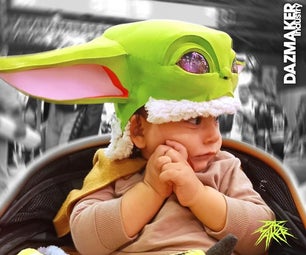Introduction: Mixed Media Art Style Earrings
I've always enjoyed making jewelry, and when I first started dabbling in the mixed media art style while making art journals, I thought, "How cool would it be to have earrings like this?" That is where the idea for these earrings came from. The thing I love about mixed media art is that sometimes it's an exploration of styles and techniques. This means there's no wrong way to do it, and most often the final piece is a beautiful surprise.
I made these earring with supplies I already have. If you don't hoard craft supplies like I do, you can find everything you need for this project at craft supply stores, hardware stores, and online.
I keep lots of craft wood pieces in my stash, and decided to make those the base for these earrings. The crackle paste and the rough circle clay centerpiece (like a wax stamp) adds that mixed media feel. I was curious to see if I could recreate the Kintsugi look by spreading paint over the cracks left by the crackle paste. It ended up looking more like marble, but I like it so I went with it. I made this pair with silver as the metal color, but you can certainly make yours with a gold or copper look if you like.
Due to drying times in several steps, this project may take a couple days. But it will definitely be worth the effort for these mixed media art style earrings!
Supplies
Materials
- Two 1.5" craft wood disks
- Wood stain (optional)
- Heavy gel gloss
- Pigment powder in your favorite color (optional)
- Crackle paste
- Clear fingernail polish
- Silver acrylic paint
- Polymer clay in silver
- Rubber stamp
- Jewelry glue (something that dries clear and works on plastic)
- Clear gloss or semi-gloss spray topcoat
- Six decorative head pins in silver color
- Beads to match: 6 decorative ones and 12 smaller accent ones (make sure they'll fit over the head pin wires)
- Ten 8mm silver colored jump rings (or eight 8mm jump rings and two 4-6mm jump rings)
- Two silver colored earring hooks
Tools
- Ruler with inch and millimeter measurements
- A drill with a 1/16" drill bit
- Extra wood block to drill into
- Pencil and eraser
- 220 grit sandpaper
- 1/4" wide flat head paint brush
- Small mixing bowl (if mixing color into crackle paste)
- Wood craft sticks for mixing and spreading
- Lint-free cloth
- Hair dryer or can of compressed air (optional)
- Parchment paper
- Flat top push pins
- A couple layers of cardboard or sturdy foam (thick enough to push the pushpins into)
- Chain-nose and round-nose jeweler's pliers
- Jeweler's wire cutters
Step 1: Prepare the Wood Disks
Mark your drill holes
I've included a template to print to make marking the drill holes easier. Make sure to print it at 100%. I just put the wood disk under the circle on the template and use a push pin or something sharp like that to poke through the centers of the dots and mark the wood. You can then use the pencil to darken the holes if you need to. You want two holes directly opposite each other and two more holes on the bottom of your disk, each equidistant from the center hole. You want them all to be about 3mm from the edge to allow room for the jump rings you will add later.
Drill the holes
Put each disk on top of a wood block. Drill the holes with a 1/16" drill bit, going through the disk and into the wood block below (see Diagram 1). Drilling into the wood block keeps the holes from splintering. • Erase any pencil markings that still show. Sand around the holes to make sure they are smooth. • If you want to stain the wood, following the manufacturer's instructions to do that. Let it dry completely before moving to the next step. If it is still tacky after a day, reapply some stain to loosen the existing stain, and then take a lint-free cloth dampened with mineral spirits to scrub away the excess. Let it dry.
Add heavy gel gloss
Apply a thin coat of heavy gel gloss to one surface. This helps the crackle paste adhere to the surface better. Smooth it out with your brush. If gel gets into the drilled holes, clear them out with the point of a push pin. Let the gel dry.
Attachments
Step 2: Adding the Crackle Paste
Adding color
If you are adding color, use a craft stick to scoop out a dollop of crackle paste (a ball about 1/2 inch or 13mm in diameter) into the small mixing bowl. Measure out a very small amount of pigment powder on just the tip of the stick to mix with the crackle paste. Mash the powder into the crackle paste, then stir, mix, and mash again really well until the color is completely mixed in. You can add a little pigment powder at a time until you achieve the color you want. Know that it will darken slightly when you paint the clear fingernail polish on in the next step. If it becomes hard to mix, add one drop of water (using a dropper) to make it easier, but be careful not to add too much or it will lose its effectiveness.
Spread the paste
Spread the crackle paste onto the wood disks on the side you previously applied gel gloss to. The thicker you apply the crackle paste, the larger the cracks. You will be filling the cracks with silver paint in the next step, and the wider the cracks are, the more you have to fill. I personally like the tiny cracks and put on a thinner layer of crackle paste, but you can experiment to see what you like.
Smooth it down
Dampen the tip of your finger with just a drop of water and smooth over the top and around the edges of the disks. Use the point of a push pin to clear out the drilled holes.
Let it dry
Then let the crackle paste dry and crack. The directions say to give it up to 3 days for it to work its magic. I live in a very dry climate, so it takes less than a day for mine to be ready, especially since it's a thin layer. It's best to let the crackle paste dry overnight just to be sure it's ready. You'll know when it's ready when the the surface is firm. If you spread the paste thin, the cracks may not show themselves except at certain angles in the light.
Sand it
When the paste is dry, use the tip of your 220 grit sandpaper to gently smooth the surface. It's OK if it's somewhat lumpy, but we want to remove sharp raised edges that would prevent the clay centerpiece from gluing on later. Plus, you will be rubbing paint off in the next step, and that's easier when the surface is somewhat smooth. When you're done sanding, clear dust out of the cracks by either blowing on it or using a hair dryer or can of compressed air.
Coat it
Paint a layer of clear nail polish over the surface of the dried crackle paste. Let it dry.
Step 3: Fill in the Cracks With Silver Paint
Straight outta the bottle
Shake your silver paint bottle, then remove the lid. Dip your 1/4" flat head paint brush in and cover the entire surface of the crackle paste. Wipe off the surface with a damp lint-free cloth to remove the excess paint. Gently wipe broadly over the surface with the cloth, making sure not to press too hard into the cracks to avoid having more paint spill out. Let the paint in the cracks dry. You may have to repeat this step a couple times to completely fill in the cracks depending on how deep they are.
Paint the sides
When you have filled in all the cracks and the paint is dry, you may want to paint the edge of the wood disk in the silver paint (especially if paint went over the edge in spots). To do this without getting more paint on top of the crackle paste, dip your flat-head paint brush into the bottle. Scrape off excess paint and then hold the brush vertically against the side of the disk (see Diagram 2) so that the tip of the paint brush is above the wood disk and not touching it. Instead of using the tip of the paint brush which will have more paint on it, you will use the flat edge. Then rub the edge of the brush around the edge of the circle.
Step 4: Add Textured Polymer Clay Centerpiece
Work, roll, and flatten the clay
Pinch off small pieces of the silver polymer clay and work them in your fingers to soften. Mash them, roll them, knead them, and then roll them into two equal ball shapes of about 1/4" (slightly more than 6mm) in diameter. Put these pieces onto a piece of parchment paper and use your thumb to press them flat to about 2mm in depth.
Stamp the texture
Press your rubber stamp firmly into the clay to add your design. If the design doesn't show up the way you want it to, just re-roll the clay, press it flat again and try pressing the rubber stamp in again until you get the look you want.
Bake it
Follow the manufacturer's instructions to bake the clay.
Glue it
Once the silver paint is dry on the wood disks and the clay centerpiece is ready to use, glue the clay piece to the center of the wood disk, carefully wiping away any glue that comes out from under the clay piece. Let that dry completely (following the manufacturer's instructions on how long to wait before you know it's dry). It is imperative the glue is completely dry before moving on to make sure your earrings don't fall apart later.
Step 5: Add Clear Gloss Topcoat
Push 3-4 push pins into your cardboard or foam work surface close enough to each other to form a platform to fit under the wood disks. Do another set for the other disk. Prop a disk on top of each set of push pins above your work surface.
In a well ventilated area, spray a layer of gloss or semi-gloss topcoat onto the disks, sweeping the spray gently back and forth over them to make sure the coat is even. Don't allow the glaze to puddle or drip over the edges. Make sure the drill holes aren't clogged up (use the opened paper clip to clear them if they are). Allow to dry for at least an hour and add another coat. Once that coat is very dry, do a couple light coats on the back.
Alternatively, you could paint on a couple layers of clear nail polish.
Make sure the topcoat is very dry before moving on to the next step!
Step 6: Make Dangles
It's time to accessorize!
To make the dangles, thread one of your smaller accent beads onto a decorative head pin. Then add one of the bigger decorative beads, and top that with another smaller accent one. Do this on all 6 decorative head pins. I added two extra silver spacer beads to mine because I thought they were pretty. You can definitely experiment with some bead combinations as long as you have at least 3/8 of an inch (about 10mm) of wire left over at the top to bend into a loop. Keep in mind that these will be hanging from your ears, so don't make them too heavy.
Form the loop
Now we will form the loop at the top of all the dangles (see Diagram 3). While holding all the beads to the bottom of the head pin, bend the wire close to the top accent bead at a 90-degree angle. Then use the wire cutters to trim the wire, leaving a 3/8 inch (about 10mm) piece of wire at the top.
Use your round-nose pliers to begin rolling the end of the wire up into a J shape. Then readjust your pliers to grasp the curve and continue rolling the wire into a loop with the wire's end tucking neatly near the top bead's hole. Do this for all 6 dangles.
Step 7: Attach Dangles and Earring Hooks
Using jump rings
Now we will attach the dangles and earring hooks using jump rings. To open the jump rings, use two pairs of pliers (using two pairs of chain-nose pliers is optimal, but one chain nose and one round nose will work as well). Grasp the ring on either side of the split and twist the sides apart in a vertical orientation, not a horizontal orientation which will ruin the shape of the ring and weaken the metal (see Diagram 4). The ring should still be round but in a spiral that will allow you to loop it into the holes of the wood disk and hang the dangles and earring hooks on.
Add dangles
For the dangles, open six 8mm jump rings, loop them into the holes at the bottom of the wood disk, and slide the dangles onto them. Then reverse the twist on the jump rings to close them. Do this to attach all 6 dangles.
Add hooks
For the earring hooks, we want to add two jump rings to the tops of each wood disks, so the earrings hang properly. Open 4 jump rings — two of these can be 8mm rings and the other two can be smaller (4mm or 6mm rings). Loop an 8mm ring into the hole at the top of a wood disk. Leave it open. Then add an earring hook to another open jump ring (this one can be the smaller one). Close the ring on the earring hook and hang that ring with the earring hook attached to the open ring on the wood disk. Make sure the earring hook is facing the back and then close that ring. Do the same for the other earring.
Step 8: You're Done!
Now you can wear your new mixed media art style earrings with pride!
You can also make more with different craft wood shapes, different depths of crackle paste, different rubber stamp designs, and other techniques to make a variety of earrings or matching necklaces in this style. Have fun!

Second Prize in the
Jewelry Challenge















4 Comments
1 year ago on Step 8
Very pretty!
Reply 1 year ago
Thank you!
1 year ago
These look great!
Reply 1 year ago
Thank you!